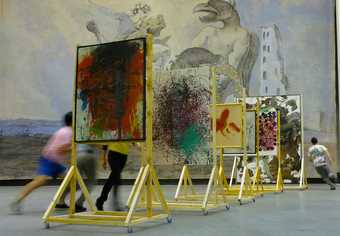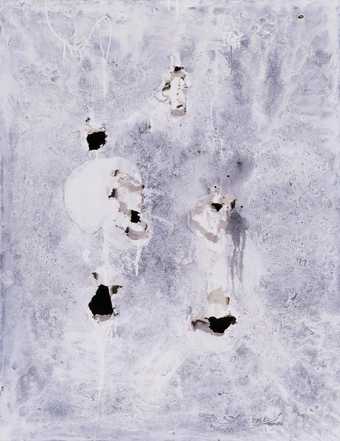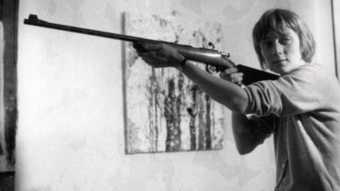
Ei Arakawa
See Weeds 2011
Courtesy of the Artists and Taka Ishii Gallery, Tokyo
Photo: Alison Vieuxmaire
Photographs of Jackson Pollock show the artist moving over and around his canvases in a kind of dance, with each painting acting as a record of his movements and gestures. In the 1950s, these images were talked about as much as the finished works themselves.
The term that is now most associated with these works, and other made in similar gestural fashion, was Action Painting. It was proposed by critic Harold Rosenberg in his 1952 article ‘The American Action Painters’:
At a certain moment the canvas began to appear to one American painter after another as an arena in which to act. … What was to go on canvas was not a picture but an event.
Though Rosenberg was not the first to suggest this idea of the painting as a site of spontaneous direct action, Action Painting was the term that caught the wider imagination, tapping into cultural ideas of macho, manly pursuits.
In Japan, in 1954, a group of young artists formed the Gutai Movement of Concrete Art. The group were well aware of Pollock’s paintings and process through Namuth’s images and were inspired by the idea of action painting, but sought to bring the action to the fore 'painting actions, not action painting'. By 1956, Jiro Yoshihara produced a manifesto for the movement:
In any case, it is obvious to us that purely formalistic abstract art has lost its charm, so that the Gutai Art Society founded three years ago was accompanied by the slogan that they would go beyond the borders of abstract art[…] In those days we thought, and indeed still do think today, that the most important merits of abstract art lie in the fact that it has opened up the possibility to create a new, subjective shape of space, one which really deserves the name creation. We have decided to pursue the possibilities of pure and creative activity with great energy. […] Our group does not impose restrictions on the art of its members, letting them make full use of their creativity.
Shozo Shimamoto created a number of paintings using actions removed from the body – smashing bottles of paint or firing a small, hand-made cannon filled with paint at the canvases. At the first Gutai exhibition in 1955, Kazuo Shiraga (best known as an artist who created gestural paintings by manipulating thick oil paint with his feet) presented Challenging Mud, a performance where he used his whole body to roll and wrestle a pile of mud into sculptured forms and shapes. Exhibiting the creation of work as performances preceded Allan Kaprow’s happenings by a few years, and they often had a focus on the documentation of these events rather than on the aesthetic value of the objects created.

Shozo Shimamoto
Holes
(1954)
Tate
Paintings had played a part in the New York happenings right from the start. In an early happening at the Judson Memorial Church in New York, Jim Dine performed his preoccupation with paint for his 1960 work The Smiling Workman. Sporting an almost Joker-like makeup of a huge black smile painted on his red face, Dine drank from pots of paint while painting the words ‘I love what I’m…’, on a canvas beside him. Finally he poured the rest of the paint over his head and jumped through the canvas.
In Europe, artists like Georges Mathieu were also focusing on the gestural manipulation of paint. Mathieu and critic Michel Tàpie were instrumental in organising the first exhibition of Pollock and other Abstract Expressionist work in Paris in 1951 and they also corresponded with the Gutai group, visiting Japan in 1957.
In Paris in 1954 Mathieu had staged a live painting action, dressed in military uniform and painting a huge canvas entitled Battle of the Bouvines. It was filmed by Robert Descharnes and written about in ARTnews by critic Michel Tapié in 1955. Though not well received in the USA, the idea of performance of creation proved highly influential. In 1964, Mathieu said:
The craftsmanship, the finish, the reliance on Greek ideals, all that is dead. Tension, density, the unknown, and mystery reign and win in every painting. For the first time in history, painting has become a performance, and you can watch its creation as you might a jam session.
In 1964 Robert Rauschenberg was touring with the Merce Cunningham dance company, producing sets for the pieces. For Story (1963) the set was different in every place it was performed in, according to Cunningham’s directions that it should be ‘devised form the existing circumstnaces and environment at the time of the performance’. At Dartington College of Art in Devon, Rauschenberg interpreted this by becoming a live set, ironing his shirt in the place a back drop might have been. By the time of the final performance in London Rauschenberg was appearing on stage at the set, executing a different painting every night. It’s possible that the confusion between set and choreography that this potentially set up could have contributed to Rauschenberg’s split from the company that year.
Painter (and judo master) Yves Klein focused on making monochromatic paintings, paintings of one single, uniform colour, most famously of his own pigment, International Klein Blue. But by 1960, Klein moved into what he entitled ‘a New Anthropometric Period’. He staged performances where he directed naked female models covered in his IKB paint to press and print their bodies on sheets of paper, accompanied by a small orchestra playing his Monotone Symphony (a composition of one single note, as the monochromatic paintings were of one single colour). Said Klein:
In this way I stayed clean. I no longer dirtied myself with colour, not even the tips of my fingers.
The macho image of action painting or painting actions was subverted by women artists of the time (and later). Carolee Schneemann’s Eye Body in 1963 was a similar step to Klein’s, in placing the body at the centre of the painting. But rather than the fully-dressed artist Klein using naked female bodies as ‘living paintbrushes’ (echoing the typical male-female power relationships depicted in art), Schneeman placed her own body at the centre of a painting construction in her loft. She saw her body as ‘an integral material’ and ‘a further dimension of the construction’.
In France, Niki de Saint Phalle used a rifle for her violent action paintings. For Shooting Painting in 1962 she shot paint-filled balloons attached to a large assemblage. As each one was hit by a bullet and burst, another colour sprayed on the surface of the painting.

Niki de Saint Phalle
Japanese artist Shigeko Kubota’s Vagina Painting, performed at the 1965 Perpetual Fluxus Festival in New York also took the idea of gestural painting, but exploded the idea of the male creative genius( and the posturing seemed to go with it). Pinning a paintbrush to her knickers, she squatted on a large piece of paper and created gestural marks.
For Janine Antoni’s Loving Care at the Anthony d’Offay Gallery, London in 1993, the artist soaked her hair in hair dye and proceeded to mop the floor of the gallery with her hair, making a feminist comment on male-dominated Action Painting, Pollock and Klein and on the perception of women in the art world and wider culture.
In considering the materiality of paint, the artists referenced above creatively explored its potenial as a medium, beyond its capacity to visually render representative imagery. Simultaneously, the very act of painting was explored as a means of creative expression in its own right. These artists and their artworks therefore speak to the complicated ways in which paint, and painting, serves not only as a visual medium, but as a performative one.
